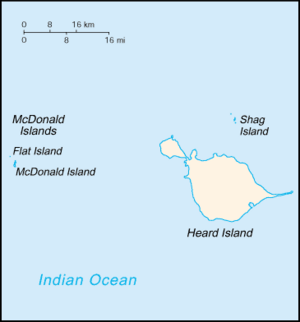McDonald Islands (Australia) facts for kids
Quick facts for kids McDonald Islands |
|
|---|---|
| Highest point | |
| Elevation | 230 m (750 ft) |
| Geography | |
| Location | Heard Island and McDonald Islands, Australia |
| Geology | |
| Mountain type | Complex volcano |
| Last eruption | July 2005 |
The McDonald Islands (53°3′34.9″S 72°35′32.2″E / 53.059694°S 72.592278°E) are a group of small islands in the southern Indian Ocean. They are located near Heard Island (53°06′S 73°31′E / 53.100°S 73.517°E). These islands are actually the tops of volcanoes that are mostly underwater. They are an external territory of Australia. Before 1992, the volcanoes had not erupted for about 75,000 years.
Contents
What are the McDonald Islands like?
The McDonald Islands are made up of three main parts: McDonald Island, Flat Island, and Meyer Rock. Flat Island later joined with McDonald Island. These islands are mostly made of a type of rock called phonolite pumice. This is a light, porous rock that forms from volcanic eruptions. They also have dikes (sheets of rock that cut through older rock) and lava domes (mound-shaped structures made of thick lava).
The islands sit on a large underwater plateau called the Kerguelen Plateau. They are about 75 kilometers (47 miles) away from Heard Island.
McDonald Island is the biggest of the group. It covers about 1 square kilometer (247 acres). Most of the recent volcanic activity has happened here. Before 1996, McDonald Island was a flat, green place. Its pumice beaches were a good spot for penguins to nest. Now, the island has two main peaks: Maxwell Hill and Samarang Hill. Maxwell Hill is the highest point, reaching 230 meters (755 feet) tall.
Volcanic Eruptions: A Fiery History
The McDonald Islands volcano was quiet for a very long time, about 75,000 years. But a series of eruptions began in 1992.
1992 Eruption
The first eruption ever recorded at the McDonald Islands happened in December 1992. It was a small eruption from an underwater opening. This eruption likely caused pumice to wash up on the shores of Heard Island.
1996–1997 Eruption
New eruptions were noticed in December 1996. An airplane pilot saw a plume of vapor rising from the islands.
At first, people thought the plume came from Heard Island's Big Ben volcano. However, on March 18, 1997, a ship's crew saw steam rising strongly from a crack on McDonald Island's steep north side. Steam also came from the island's northern peak. The steam came from a slope covered in rubble. This showed that a lava flow or a pyroclastic flow (a fast-moving mix of hot gas and volcanic rock) had happened.
On April 2, 1997, another ship's crew saw that steam was still coming from the crack. They also saw lava flowing down valleys. These lava flows covered a large part of the island's north side. Sulphur deposits were found, and fresh pumice washed up on Heard Island. This eruption is thought to have ended sometime between January and March 1997.
2001 Eruption
Another eruption started at McDonald Island in 2001. A ship passing by the islands first spotted it. Volcanic material was shooting out from the sides of the island, especially in the north and northwest. Steam was also coming from near the top crater.
Before the ship's visit, the volcano had been erupting. It covered the island in dark, smooth material. Many features, like Williams Bay, were filled in. The eruptions also connected Flat Island to McDonald Island. About 400 meters (1,312 feet) of new land was added. A new volcanic cone was also formed. In November 2002, two new lava domes were seen, but it's not known exactly when they formed.
2005 Eruption
Scientists looked at satellite pictures and saw that an eruption happened on July 12, 2005. This eruption was on the northwest shore of the island. It might have added a small amount of new land to the island's area.
Protecting the Islands
In 2002, the Heard Island and McDonald Islands area was made a marine reserve. This means it's a protected ocean area. The reserve was made even bigger in 2014. The islands are also recognized as a World Heritage Site. This means they are very important and protected for everyone to enjoy.


